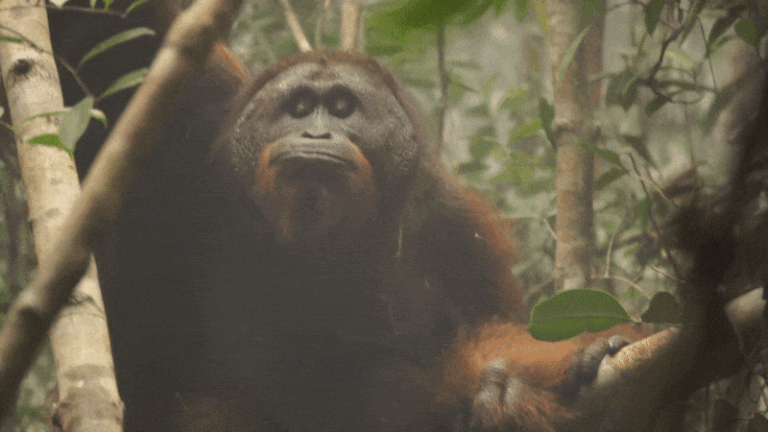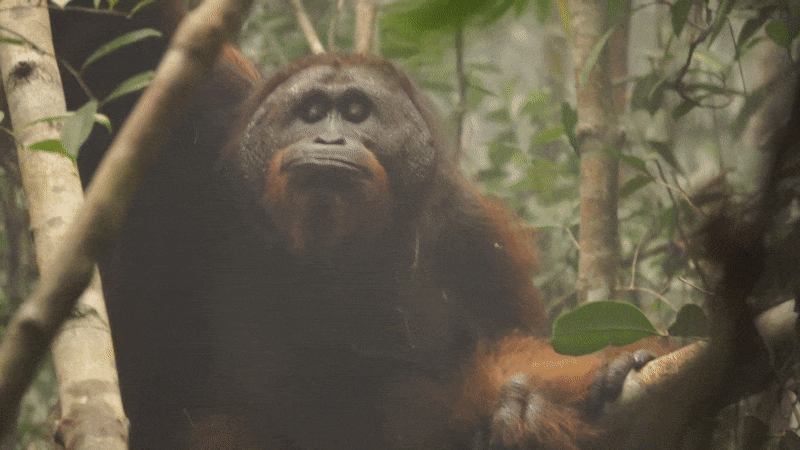
[ad_1]

[CLIP: Orangutan call]
Starre Vartan: This is Scientific American’s Science, Quickly. I’m Starre Vartan.
[CLIP: Orangutan call]
That remarkable sound comes from a wild male orangutan. He lives in the Indonesian part of the island of Borneo.
And he is looking for a mate.
His call is meant to pierce the thickly vegetated tropical peat forest where he lives his mostly solitary life.
Vartan: What you can’t hear in his voice—and researchers studying these primates can detect—is that it’s now a bit raggedy, slightly hoarse.
You’ve heard it in plenty of classic films: it’s a smoker’s voice.
We’ll get back to just where this orangutan’s smoker’s voice came from in a bit. But first, let’s meet our guide.
Wendy Erb: I go to the island of Borneo. That’s been a pretty constant feature of my research.
Vartan: This is Wendy Erb. She’s a behavioral ecologist and biological anthropologist at Cornell University.
Erb: This particular population of orangutans, we refer to that site as Tuanan. That’s the name of the village that’s right next to that forest area where we have the trails and the habituated animals in our little camp.
Vartan: Orangutans are known for being the most solitary of the great apes. Despite their penchant for living solo, males need to be able to communicate with females over long distances.
Erb: They also want to let other flanged males know who might be listening in the area that they will not tolerate the presence of another male.
Vartan: “Flanged” refers to the large cheek pads and pendulous throat sacs that some male orangutans have. They use them as sound boosters to project their long call, which you just heard, to both welcome—and warn—other orangutans in earshot.
Erb: So they use these signals to, you know, as sort of a lure—as a carrot and a stick, depending on who’s listening. And so there must be a lot of information that’s carried in these calls that is relevant to listeners.
Vartan: To pick up on these treetop conversations, Wendy and her colleagues track the orangutans while wearing a peculiar-looking backpack that has a big mic sticking out of it.
She and her team also collect urine and feces samples. Making these collections is messy, but the orangutans’ pee and droppings are full of relevant information, such as their hormone levels and other health indicators.
It isn’t easy work.
Erb: I had been out there, following around orangutans for many months, making recordings of their sounds, collecting their poop and pee, obsessively writing down everything they were eating, everything that they were, every animal they were interacting with, where they were moving.
Vartan: When Wendy says “out there,” she means the Indonesian peat swamp forest.
She and her colleagues traverse this environment at all times of the night and day, collecting data every two minutes. Their watch alarm tells them when it’s time.
[CLIP: Beeping sound from watch]
Vartan: As you might imagine, it’s a place that’s often just soaking.
Erb: We’re talking about knee-height water, somewhere between the ankle and knee. There are a lot of lianas, or vines. Having a machete in hand is definitely very helpful for getting through this habitat. People will usually fall down a lot when they first start working in this habitat because, you know, it’s hard to tell whether the ground is gonna give under your foot or not.
[CLIP: Erb walking in wet forest]
Erb: So it’s like when you’re walking through these flooded forests at 3 A.M. to get orangutan nests, and you’re slosh, slosh, sloshing. Every time, you slosh. At least for me, I kind of gently test first before I fully commit. If you go through and stomp, stomp, stomp, chances are you’re going to end up in a big hole.
Vartan: But what you might not think, given all of that sloshing, is that the peat swamp is only swampy for part of the year.
There is a dry season. And you’d think that might offer researchers a reprieve and easier data gathering. But in 2015 it brought with it devastating peat fires. Wendy was there.
[CLIP: Fire sounds]
Erb: The smoke is just—it’s unbelievable. And it’s unrelenting. And it’s, it’s just months and months of burning eyes and scratchy throats and stuffy noses and just generally feeling awful.
Vartan: While this region has experienced these fires in the past, like other types of wildfire, peat wildfires have gotten much worse over the past few decades. Humans have altered the structure of the forests through clearing land for farming, which drains the natural peat swamp forests.
Erb: When the water table drops low enough and long enough, all the stuff above the water table can get really dry and becomes like incredible tinder.
Vartan: Smoke from peatland wildfires contains a number of hazardous components, including carbon monoxide and sulfur dioxide, other gases, and particles of various sizes.
Particles with a diameter of 2.5 microns or smaller, or PM2.5, are especially dangerous: because of their tiny size, they can penetrate vascular tissue. When you breathe them in, toxic particulates can make their way into the bloodstream and have been linked to lung and heart damage, immune system damage and inflammation in humans and animals.
Erb: It’s terrifying when I think back about how dangerous—how dangerous that air quality was, as I now understand what a significant risk [it was] to my health, to the health of the entire research team and, of course, all the communities who live there and have to go through these terrible conditions.
Vartan: Research took a back seat to the immediate threat of the fires.
Erb: Our entire research team became [a] firefighting team. And so rather than carrying around binoculars in the forest, we were carrying around fire hoses or bringing equipment to the—to the various teams that came in to help extinguish the fires with us.
[CLIP: Fire sounds]
Erb: We couldn’t even collect data for the sort of most intense month, when the air quality was the worst and the fires were the most intense, because we just didn’t have the resources to be able to continue observing the animals and collecting data.
Vartan: After Wendy and her team were able to pick their binoculars back up, she saw a new research hypothesis materialize amid the smoke.
Erb: I think we can conclude pretty confidently that this is a dangerous, hazardous component of smoke pollution that affects a lot of different animals.
Vartan: But Wendy wanted to know how this smoke affected orangutans, specifically. She first published a study in 2018 where she and her colleagues looked at behavioral changes, as well as the overall health of the orangutans, in response to wildfire smoke.
Erb: We found that the animals were resting more, they were traveling less, they were covering shorter distances. They were even consuming more calories in their diet.
Vartan: This effect is found in humans, too. It’s caused by the energy required by the whole-body immune response to smoke inhalation.
But when a solitary wild animal eats more and moves less but still ends up using more energy and turns to fat stores, that’s a big deal.
Erb: The fact that their behavior is changing could also sort of have knock-on effects in terms of what they’re eating and who they’re socializing with. If they’re resting, or if they’re traveling less or covering less territory, that influences the likelihood of animals coming into contact with each other.
Vartan: But that’s behavior. Wendy also wanted to see if the smoke had affected the animals’ ability to talk to each other.
Before the fires first started, she and her team had recorded hundreds of hours of orangutan long calls. While the fires were burning in the region but before they got too close, she made more.
Erb: There were four males that we followed and collected recordings from. So we were able to focus on these four males and compare them to themselves both before the fire and smoke and after the fire and smoke.
[CLIP: Orangutan pre-exposure call]
Vartan: That’s the presmoke call from a male named Wodan.
And here is Wodan’s call just three months later, after smoke exposure.
[CLIP: Orangutan post-exposure call]
Erb: I’m using terms like raspy, raggedy, hoarse. Maybe it sounded a little bit like somebody with a smoker’s cough or the smoker’s voice.
Vartan: She compares it to how humans sound because orangutans and people have similar vocal structures.
By deeply analyzing the changes in 132 orangutan long calls, Wendy found that during the fires—and for several weeks after the smoke had cleared—orangutans called less, and their voices dropped in pitch, showing more vocal harshness and irregularities. The findings were published in June.
Collectively, these features of vocal quality have been linked to inflammation, stress and disease.
Now she’s got a proxy: she can link the sound of the long calls to orangutan stress from wildfire smoke. This allows her to track and understand orangutan health while keeping her team safer.
And Wendy’s research could be applied to other primates that endure wildfire smoke and possibly even other types of mammals with similar vocal structures to orangutans and humans.
For now, the skies are clear over Borneo, but Wendy will continue to track how fire affects wildlife in Indonesian forests as the world warms.
[CLIP: Orangutan long call]
Vartan: Science, Quickly is produced by Jeff DelViscio, Tulika Bose, Kelso Harper and Carin Leong. Our theme music was composed by Dominic Smith.
Don’t forget to subscribe to Science, Quickly wherever you get your podcasts. For more in-depth science news and features, go to ScientificAmerican.com.
For Scientific American’s Science, Quickly, I’m Starre Vartan.
[ad_2]